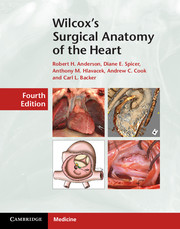Book contents
- Frontmatter
- Contents
- Preface
- Acknowledgements
- Surgical approaches to the heart
- Anatomy of the cardiac chambers
- Surgical anatomy of the valves of the heart
- Surgical anatomy of the coronary circulation
- Surgical anatomy of the conduction system
- Analytical description of congenitally malformed hearts
- Lesions with normal segmental connections
- Lesions in hearts with abnormal segmental connections
- Abnormalities of the great vessels
- Positional anomalies of the heart
- Index
- References
Anatomy of the cardiac chambers
Published online by Cambridge University Press: 05 September 2013
- Frontmatter
- Contents
- Preface
- Acknowledgements
- Surgical approaches to the heart
- Anatomy of the cardiac chambers
- Surgical anatomy of the valves of the heart
- Surgical anatomy of the coronary circulation
- Surgical anatomy of the conduction system
- Analytical description of congenitally malformed hearts
- Lesions with normal segmental connections
- Lesions in hearts with abnormal segmental connections
- Abnormalities of the great vessels
- Positional anomalies of the heart
- Index
- References
Summary
Regardless of the surgical approach, once having entered the mediastinum, the surgeon will be confronted by the heart enclosed in its pericardial sac. In the strict anatomical sense, this sac has two layers, one fibrous and the other serous. From a practical point of view, the pericardium is essentially the tough fibrous layer; the serous component forms the lining of the fibrous sac, and is reflected back onto the surface of the heart as the epicardium. It is the fibrous sac, therefore, which encloses the mass of the heart. By virtue of its own attachments to the diaphragm, it helps support the heart within the mediastinum. Free-standing around the atrial chambers and the ventricles, the sac becomes adherent to the adventitial coverings of the great arteries and veins at their entrances to and exits from it, these attachments closing the pericardial cavity. The cavity of the pericardium is limited by the two layers of serous pericardium, which are folded on one another to produce a double-layered arrangement. The outer or parietal layer is densely adherent to the fibrous pericardium, while the inner layer is firmly attached to the myocardium, and is the epicardium (Figure 2.1). The pericardial cavity, therefore, is the space between the inner parietal serous lining of the fibrous pericardium and the surface of the heart (Figure 2.2). There are two recesses within the cavity that are lined by serous pericardium. The first is the transverse sinus, which occupies the inner curvature of the heart (Figure 2.3). Anteriorly, it is bounded by the posterior surface of the great arteries. Posteriorly, it is limited by the right pulmonary artery and the roof of the left atrium. There is a further recess from the transverse sinus that extends between the superior caval and the right upper pulmonary veins, with its right lateral border being a pericardial fold between these vessels (Figure 2.4). When exposing the mitral valve through a left atriotomy, incisions through this fold, along with mobilisation of the superior caval vein, provide excellent access to the superior aspect of the left atrium and the right pulmonary artery. This fold is also incised when a snare is placed around the superior caval vein. Laterally, on each side, the ends of the transverse sinus are in free communication with the remainder of the pericardial cavity.
- Type
- Chapter
- Information
- Wilcox's Surgical Anatomy of the Heart , pp. 13 - 50Publisher: Cambridge University PressPrint publication year: 2013
References
- 1
- Cited by

